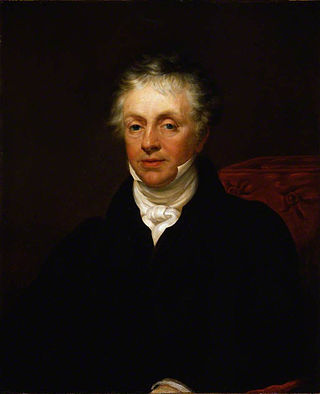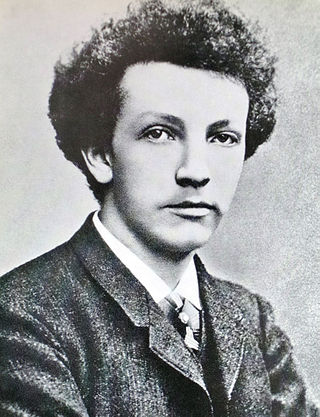Related Research Articles

In classical music, a fugue is a contrapuntal, polyphonic compositional technique in two or more voices, built on a subject that is introduced at the beginning in imitation, which recurs frequently throughout the course of the composition. It is not to be confused with a fuguing tune, which is a style of song popularized by and mostly limited to early American music and West Gallery music. A fugue usually has three main sections: an exposition, a development, and a final entry that contains the return of the subject in the fugue's tonic key. Fugues can also have episodes—parts of the fugue where new material is heard, based on the subject—a stretto, when the fugue's subject "overlaps" itself in different voices, or a recapitulation. A popular compositional technique in the Baroque era, the fugue was fundamental in showing mastery of harmony and tonality as it presented counterpoint.

Carl Friedrich Abel was a German composer of the pre-Classical era. He was a renowned player of the viola da gamba, and produced significant compositions for that instrument. He was director of music at the Dresden court from 1743, and moved to London in 1759, becoming chamber-musician to Queen Charlotte in 1764. He founded a subscription concert series there with Johann Christian Bach. According to the Catalogue of Works of Carl Friedrich Abel (AbelWV), he left 420 compositions, with a focus on chamber music.

A symphony is an extended musical composition in Western classical music, most often for orchestra. Although the term has had many meanings from its origins in the ancient Greek era, by the late 18th century the word had taken on the meaning common today: a work usually consisting of multiple distinct sections or movements, often four, with the first movement in sonata form. Symphonies are almost always scored for an orchestra consisting of a string section, brass, woodwind, and percussion instruments which altogether number about 30 to 100 musicians. Symphonies are notated in a musical score, which contains all the instrument parts. Orchestral musicians play from parts which contain just the notated music for their own instrument. Some symphonies also contain vocal parts.

Charles-Camille Saint-Saëns was a French composer, organist, conductor and pianist of the Romantic era. His best-known works include Introduction and Rondo Capriccioso (1863), the Second Piano Concerto (1868), the First Cello Concerto (1872), Danse macabre (1874), the opera Samson and Delilah (1877), the Third Violin Concerto (1880), the Third ("Organ") Symphony (1886) and The Carnival of the Animals (1886).

Sir Charles Hubert Hastings Parry, 1st Baronet, was an English composer, teacher and historian of music. Born in Richmond Hill in Bournemouth, Parry's first major works appeared in 1880. As a composer he is best known for the choral song "Jerusalem", his 1902 setting for the coronation anthem "I was glad", the choral and orchestral ode Blest Pair of Sirens, and the hymn tune "Repton", which sets the words "Dear Lord and Father of Mankind". His orchestral works include five symphonies and a set of Symphonic Variations. He also composed the music for Ode to Newfoundland, the Newfoundland and Labrador provincial anthem.
A symphonic poem or tone poem is a piece of orchestral music, usually in a single continuous movement, which illustrates or evokes the content of a poem, short story, novel, painting, landscape, or other (non-musical) source. The German term Tondichtung appears to have been first used by the composer Carl Loewe in 1828. The Hungarian composer Franz Liszt first applied the term Symphonische Dichtung to his 13 works in this vein, which commenced in 1848.

Jan Pieterszoon Sweelinck was a Dutch composer, organist, and pedagogue whose work straddled the end of the Renaissance and beginning of the Baroque eras. He was among the first major keyboard composers of Europe, and his work as a teacher helped establish the north German organ tradition.

John Bull was an English composer, organist, virginalist and organ builder. He was a renowned keyboard performer of the virginalist school and most of his compositions were written for this medium.
A fantasia is a musical composition with roots in improvisation. The fantasia, like the impromptu, seldom follows the textbook rules of any strict musical form.
John Wilbye was an English madrigal composer.

Thomas Attwood was an English composer and organist. Attwood studied under Mozart and he was friendly with Felix Mendelssohn.

Hugh Seymour Davies was a musicologist, composer, and inventor of experimental musical instruments.
"Flow, my tears" is a lute song by the accomplished lutenist and composer John Dowland (1563–1626). Originally composed as an instrumental under the name "Lachrimae pavane" in 1596, it is Dowland's most famous ayre, and became his signature song, literally as well as metaphorically: he would occasionally sign his name "Jo: dolandi de Lachrimae".
Carolus Hacquart was a Flemish composer and musician. He became one of the most important 17th-century composers in the Dutch Republic and possibly also worked in England.

James Hewitt was an American conductor, composer, and music publisher. Born in Dartmoor, England, he was known to have lived in London in 1791 and early 1792, but went to New York City in September of that year. He stayed in New York until 1811, conducting a theater orchestra and composing and arranging music for local ballad operas and musical events. He also gave lessons and sold musical instruments and publications in his "musical repository".

The tone poems of Richard Strauss are noted as the high point of program music in the latter part of the 19th century, extending its boundaries and taking the concept of realism in music to an unprecedented level. In these works, he widened the expressive range of music while depicting subjects many times thought unsuitable for musical depiction. As Hugh MacDonald points out in the New Grove Dictionary of Music and Musicians, "In the years prior to World War I these works were held to be in the vanguard of modernism."

Baroque music refers to the period or dominant style of Western classical music composed from about 1600 to 1750. The Baroque style followed the Renaissance period, and was followed in turn by the Classical period after a short transition. The Baroque period is divided into three major phases: early, middle, and late. Overlapping in time, they are conventionally dated from 1580 to 1650, from 1630 to 1700, and from 1680 to 1750. Baroque music forms a major portion of the "classical music" canon, and is widely studied, performed, and listened to. The term "baroque" comes from the Portuguese word barroco, meaning "misshapen pearl". The works of George Frideric Handel and Johann Sebastian Bach are considered the pinnacle of the Baroque period. Other key composers of the Baroque era include Claudio Monteverdi, Domenico Scarlatti, Alessandro Scarlatti, Alessandro Stradella, Tomaso Albinoni, Johann Pachelbel, Henry Purcell, Antonio Vivaldi, Georg Philipp Telemann, Jean-Baptiste Lully, Jean-Philippe Rameau, Marc-Antoine Charpentier, Arcangelo Corelli, François Couperin, Johann Hermann Schein, Heinrich Schütz, Samuel Scheidt, Dieterich Buxtehude, Gaspar Sanz, José de Nebra, Antonio Soler, Carlos Seixas and others.
John Lugge was an English organist and composer, who spent most of his musical career at Exeter Cathedral.

Drexel 5611 is a 17th-century music manuscript compilation of works written for virginal. Dating from either the end of the Commonwealth period or the early Restoration period, it is an important source for English keyboard music. It also includes a handful of works by French composers, reflecting the growing interest among English musicians in contemporary French keyboard music.
John Tomkins was a Welsh-born organist and composer, a half-brother of the composer Thomas Tomkins. He was organist at St Paul's Cathedral in London from 1619.
References
- ↑ Jeans, Susi (2001). "Facy, Hugh". In Sadie, Stanley; Tyrrell, John (eds.). The New Grove Dictionary of Music and Musicians (2nd ed.). London: Macmillan Publishers. ISBN 978-1-56159-239-5.
- ↑ "HOASM: Hugh Facy (Facey, etc.)" . Retrieved 3 November 2008.
- ↑ Grove, George (1955). Eric Blom (ed.). Grove's Dictionary of Music and Musicians . St. Martin's Press.
- 1 2 Maxim, Christopher (Autumn 2001). "A postcard from Rome?". Musical Times. doi:10.2307/1004621. JSTOR 1004621.